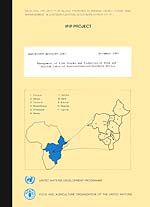
| UNDP/FAO Regional Project for Inland Fisheries Planning | RAF/87/099-WP/02/89 (EN) |
| Development and Management in Eastern/Central/Southern Africa |
| RAF/87/099-WP/02/89 (EN) | December 1989 |
 | Management of Fish Stocks and Fisheries of Deep and Shallow Lakes of Eastern/Central/Southern Africa |
by
George W. Ssentongo
Fisheries Biologist
IFIP Project
The conclusions and recommendations given in this and other reports in the IFIP project series are those considered appropriate at the time of preparation. They may be modified in the light of further knowledge gained at subsequent stages of the Project. The designations employed and the presentation of material in this publication do not imply the expression of any opinion on the part of FAO or UNDP concerning the legal status of any country, territory, city or area, or concerning the determination of its frontiers or boundaries.
PREFACE
The IFIP project started in January 1989 with the main objective of promoting a more effective and rational exploitation of the fisheries resources of major water bodies of Eastern, Central and Southern Africa. The project is executed by the Food and Agriculture Organisation of the United Nations (FAO), and funded by the United Nations Development Programme (UNDP) for a duration of four years.
There are eleven countries and three intergovernmental organisations participating in the project: Burundi, Ethiopia, Kenya, Malawi, Mozambique, Uganda, Rwanda, Tanzania, Zambia, Zaire, Zimbabwe, The communauté Economique des Pays des Grands Lacs (CEPGL), The Preferential Trade Area for Eastern and Southern African States (PTA) and the Southern African Development Coordination Conference (SADCC).
The immediate objectives of the project are: (i) to strengthen regional collaboration for the rational development and management of inland fisheries, particularly with respect to shared water bodies; (ii) to provide advisory services and assist Governments in sectoral and project planning; (iii) to strengthen technical capabilities through training; and (iv) to establish a regional information base.
This document has been prepared under the framework of the project. It gives basic information on the exploited fish stocks and fisheries of lakes in Eastern/Central/Southern Africa. It highlights problems of development and rational management of inland fisheries and gives several strategies for solving those problems. The information contained in this document will be updated during the present phase of the project. This document is issued in English.
IFIP PROJECT
FAO
B.P 1250
BUJUMBURA
BURUNDI
| Telex: FOODAGRI BDI 5092 | Tel. 2.4328 |
IFIP PUBLICATIONS
Publications of the IFIP project are issued in two series:
A series of technical documents (RAF/87/099-TD) related to meetings, missions and research organized by the project.
A series of working papers (RAF/87/099-WP) related to more specific field and thematic investigations conducted in the framework of the project.
For both series, reference is further made to the document number (2), the year of publication (89) and the language in which the document is issued: English (En) or French (Fr).
For bibliographic purposes this document should be cited as follows:
Ssentongo G.W., 1989 Management of fish stocks and fisheries of deep and shallow lakes of Eastern/Central/Southern Africa. UNDP/FAO Regional Project for Inland Fisheries Planning (IFIP). RAF/87/099-WP/02/89 (En): 19 p.
FOOD AND AGRICULTURE ORGANIZATION OF THE UNITED NATIONS
UNITED NATIONS DEVELOPMENT PROGRAMME
Bujumbura. December 1989
Hyperlinks to non-FAO Internet sites do not imply any official endorsement of or responsibility for the opinions, ideas, data or products presented at these locations, or guarantee the validity of the information provided. The sole purpose of links to non-FAO sites is to indicate further information available on related topics.
This electronic document has been scanned using optical character recognition (OCR) software. FAO declines all responsibility for any discrepancies that may exist between the present document and its original printed version.
3. BIOLOGICAL PRODUCTIVITY OF LAKES
3.1 Lakes with Conductivity less than 600 μ mhos
3.2 Lakes with Conductivity of 600-6000 μ mhos
3.3 Lakes with Conductivity greater than 6000 μ mhos
4. FISHERY RESOURCES OF THE LARGER AND DEEPER LACUSTRINE SYSTEMS
5. FISHERY PROBLEMS AND POSSIBLE SOLUTIONS
5.1 How to determine levels of sustainable fishing using fish population models
5.2 The role of ecological models
5.3 The problem of overfishing
5.5 Problems of exploited fish stocks and effects of overfishing
5.6 Rational use of fishery biostatistical data on lakes of Eastern/Central/Southern Africa